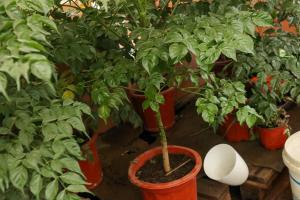Introduction
Tomato plants are popular among gardeners and homeowners alike due to the delicious and healthy fruit they produce. However, it can be disheartening to see these plants die off after producing a bumper crop. The reasons for this occurrence are many, ranging from environmental factors to pests and diseases. In this article, we will explore the various factors that can lead to tomato plant death after fruiting.
Lack of Nutrients
One of the primary reasons for tomato plant death after fruiting is a lack of nutrients. Tomato plants require a balanced supply of macronutrients, such as nitrogen, phosphorus, and potassium. A lack of these nutrients can result in poor fruit production and subsequent death. Additionally, micronutrients such as calcium, magnesium, and iron are also essential for tomato plant health. A soil test can help determine if the soil is deficient in any nutrients, and fertilizers can be applied accordingly.
Lack of Water
Another common reason for tomato plant death after fruiting is a lack of water. Tomato plants require regular watering to maintain optimal growth. Without adequate water, they can become stressed, resulting in wilted and yellow leaves, stunted growth, and poor fruit production. It is also essential to avoid overwatering as this can lead to root rot and other fungal diseases.
Pests and Diseases
Tomato plants are vulnerable to a range of pests and diseases that can cause plant death after fruiting. Common pests include aphids, spider mites, and whiteflies, while common diseases include blossom end rot, fungal infections, and bacterial wilt. It is essential to identify and address any pest or disease issues promptly, as untreated problems can quickly spread throughout the plant and lead to its demise.
Environmental Factors
Tomato plants are sensitive to environmental factors such as temperature, humidity, and light. High temperatures can cause the plant to wilt and reduce fruit production, while low temperatures can stunt growth and kill the plant outright. Humidity levels that are too high or too low can also affect tomato plant health, as can insufficient or excessive light.
Harvesting
Improper harvesting can also contribute to tomato plant death. When fruits are not harvested at their peak or are left to overripen on the vine, the plant can become exhausted, leading to a decline in overall health. It is essential to harvest fruits at the correct time and to remove any diseased or damaged fruits promptly.
Conclusion
In conclusion, tomato plant death after fruiting can be caused by a variety of factors, including nutrient deficiencies, lack of water, pest and disease problems, environmental factors, and improper harvesting. By addressing these issues promptly and providing optimal growing conditions, gardeners can increase their chances of producing healthy and productive tomato plants year after year.

 how many times do yo...
how many times do yo... how many planted tre...
how many planted tre... how many pine trees ...
how many pine trees ... how many pecan trees...
how many pecan trees... how many plants comp...
how many plants comp... how many plants can ...
how many plants can ... how many plants and ...
how many plants and ... how many pepper plan...
how many pepper plan...































